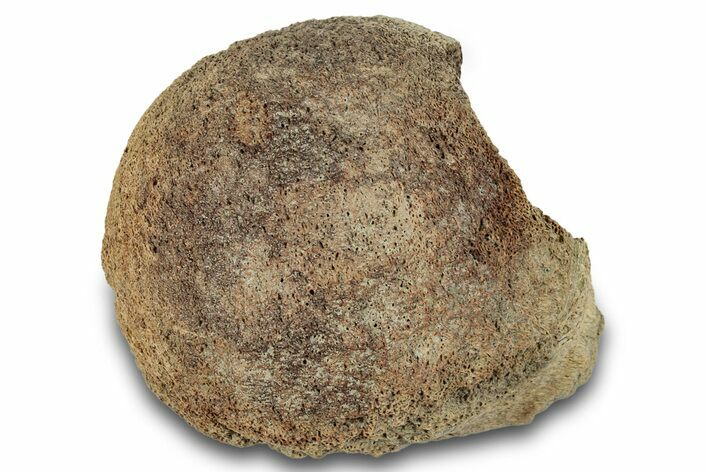This Specimen has been sold.
2.9" Fossil Ceratopsian Occipital Condyle - Judith River Formation
This is a 2.9" wide occipital condyle from the skull of a ceratopsian dinosaur, collected from the Late Cretaceous-aged Judith River Formation in Montana. Ceratopsian dinosaurs had a single occipital condyle at the center of their skull, balancing their frill and skull like a teeter-totter. Their first three cervical vertebrae (syncervical) were naturally fused together, reducing their flexibility but allowing them to hold up and rotate their massive heads. These vertebrae articulated with their occipital condyle.
It comes in an acrylic display case.
Within the Judith River Group there are multiple ceratopsid genera and species, so with just a single bone or tooth they are hard to differentiate and give a definitive identification. However, it's likely that the genus is either Chasmosaurus or Centrosaurus.
Ceratopsians are a group of plant-eating dinosaurs from the Cretaceous characterized by a bony frill on the back of the skull and a unique upper beak bone, called a rostral. Ceratopsians ranged in size from 1 meter (3 ft) and 23 kilograms (50 lb) to over 9 meters (30 ft) and 9,100 kg (20,100 lb). Triceratops is by far the best-known ceratopsian to the general public.
It comes in an acrylic display case.
Within the Judith River Group there are multiple ceratopsid genera and species, so with just a single bone or tooth they are hard to differentiate and give a definitive identification. However, it's likely that the genus is either Chasmosaurus or Centrosaurus.
Ceratopsians are a group of plant-eating dinosaurs from the Cretaceous characterized by a bony frill on the back of the skull and a unique upper beak bone, called a rostral. Ceratopsians ranged in size from 1 meter (3 ft) and 23 kilograms (50 lb) to over 9 meters (30 ft) and 9,100 kg (20,100 lb). Triceratops is by far the best-known ceratopsian to the general public.
About the Judith River Formation
The Judith River Formation is one of the world's most prolific sources of Late Cretaceous vertebrate fossils. At least sixteen Orders containing more than forty Genera are known from the formation. These include fish, amphibians, mammals, and insects in addition to reptiles and avian (birds) and non-avian dinosaurs. Among the more interesting specimens is Leonardo, a mummified and fossilized Brachylophosaurus. This is a hadrosaur, a duck-billed dinosaur found with amazing soft-tissue preservation: skin impressions can be found on 90 percent of its body! The pattern in the skin on its feet is even preserved. In addition to Leonardo, the Judith River Formation contains the remains of the theropod Hesperornis, the only known freshwater Hespernorthid, a penguin-like bird.
The Judith River Formation is one of the world's most prolific sources of Late Cretaceous vertebrate fossils. At least sixteen Orders containing more than forty Genera are known from the formation. These include fish, amphibians, mammals, and insects in addition to reptiles and avian (birds) and non-avian dinosaurs. Among the more interesting specimens is Leonardo, a mummified and fossilized Brachylophosaurus. This is a hadrosaur, a duck-billed dinosaur found with amazing soft-tissue preservation: skin impressions can be found on 90 percent of its body! The pattern in the skin on its feet is even preserved. In addition to Leonardo, the Judith River Formation contains the remains of the theropod Hesperornis, the only known freshwater Hespernorthid, a penguin-like bird.
SPECIES
Chasmosaurus or Centrosaurus
LOCATION
Hill County, Montana
FORMATION
Judith River Formation
SIZE
2.9 x 2.6 x 1.8"
CATEGORY
SUB CATEGORY
ITEM
#266018
We guarantee the authenticity of all of our specimens.
 Reviews
Reviews











